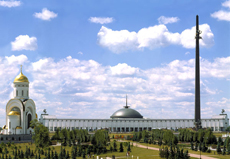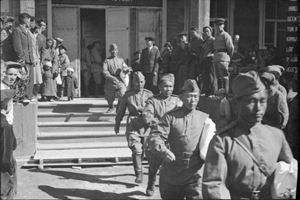 In May 2010, in Moscow, on the eve of Day of Victory, an exhibition will open concerning the role of Tuva in the Great Patriotic War. This was announced by the head of the republic, Sholban Kara-ool, at the meeting dedicated to the Day of National Unity. In May 2010, in Moscow, on the eve of Day of Victory, an exhibition will open concerning the role of Tuva in the Great Patriotic War. This was announced by the head of the republic, Sholban Kara-ool, at the meeting dedicated to the Day of National Unity.
At the recommendation of the Premier, the agreement about the placement of the Tuvan exposition in the museum complex at Poklonnaya mountain was reached with the administration of the museum. Remember that Tuvan National Republic (an independent state from 1921 to 1944) was one of the first states to officially react to the German attack of the Soviet Union. On June 22, 1941, the delegates of a regular meeting of the Great Khural of TNR in Kyzyl unanimously declared war.
 The declaration said: “The Tuvan nation with the entire revolutionary party and its government at its head, without sparing their lives, is prepared with all its strength and means to participate in the fight of the Soviet Union against the fascist aggressors until the final victory over them.” The gold reserve of the republic was given over to Moscow (around 30 million rubles). The declaration said: “The Tuvan nation with the entire revolutionary party and its government at its head, without sparing their lives, is prepared with all its strength and means to participate in the fight of the Soviet Union against the fascist aggressors until the final victory over them.” The gold reserve of the republic was given over to Moscow (around 30 million rubles).
From June 1941 until October 1944, Tuva sent five military trains of presents to the front, sending 50 thousand horses, 52 thousand pairs of skis, 12 thousand fur coats, 15 thousand pairs of felt boots, 70 thousand tons of sheep wool, several hundred thousand tons of meat, carts, sleighs, horse equipment and other goods to the total sum of about 66.5 million rubles for the needs of the Red Army
Several dozen of fighter planes were purchased for the contributions by the population.
In 1942, the soviet government permitted to accept volunteers from Tuva into the army. Altogether more than 4000 people from TNR went to the front.
The first Tuvan volunteers entered the ranks of the Red Army in May 1943, and were included into the 25th tank regiment ( from February 1944 in the system of the 52nd Army of the 2nd Ukraine front), which participated in the fighting on the territory of Ukraine, Moldavia, Romania, Hungary and Czechoslovakia.
 In 1943, the second group of volunteers (206 people) entered into the 8th Cavalry division. “The wild Asians” (that is what our countrymen were called by a “tongue” captured by our intelligence) who opposed tanks and heavy artillery on their small tough horses, were called “schwarze Tod” -black death- by the Germans, for their impetuosity, fearlessness and audacity. In 1943, the second group of volunteers (206 people) entered into the 8th Cavalry division. “The wild Asians” (that is what our countrymen were called by a “tongue” captured by our intelligence) who opposed tanks and heavy artillery on their small tough horses, were called “schwarze Tod” -black death- by the Germans, for their impetuosity, fearlessness and audacity.
In Tuva, a new memorial is to be opened for the anniversary of the Victory, dedicated to the Soldier of the Great Patriotic War. The names of all the Tuvan volunteers who went to the battles of the front will be engraved there.
Remember that in the framework of the Agreement about co-operation between the mayor of Moscow and the government of Tuva, at the Poklonnaya mountain, there are also plans to build a Buddhist temple, dedicated to the memory of the soldiers-Buddhists, who took part in the great Patriotic War. A Russian Orthodox church, a synagogue and a mosque are already there.
Photos: the museum complex at Poklonnaya mountain (Moscow), photos from the archives of the Natinal Museum of Tuva, by Vladimir Yermolayev. Parades of Tuvan tank soldiers on May 20, 1943 from Stalin’s club ( currently the location of the State Philharmony), and comrades Usov and Boris Lama.
|
